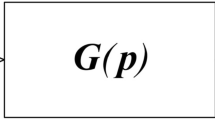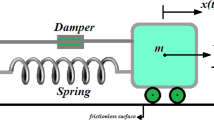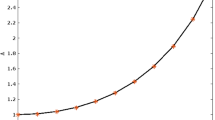Abstract
A time integration algorithm for structural dynamic analysis is proposed by uniform cubic B-spline functions. The proposed algorithm is successfully used to solve the dynamic response of a single degree of freedom (SDOF) system, and then is generalized for a multiple-degree of freedom (MDOF) system. Stability analysis shows that, with an adjustable algorithmic parameter, the proposed method can achieve both conditional and unconditional stabilities. Validity of the method is shown with four numerical simulations. Comparison between the proposed method and other methods shows that the proposed method possesses high computation accuracy and desirable computation efficiency.
Similar content being viewed by others
References
Wilson, E. L., Farhoomand, I., and Bathe K. J. Nonlinear dynamic analysis of complex structures. Earthquake Engineering and Structural Dynamics, 1, 241–252 (1972)
Chung, J. and Hulbert G. M. A time integration algorithm for structural dynamics with improved numerical dissipation: the generalized-α method. Journal of Applied Mechanics, 60, 371–375 (1993)
Bathe, K. J. Conserving energy and momentum in nonlinear dynamics: a simple implicit time integration scheme. Computers and Structures, 85, 437–445 (2007)
Liu, T., Zhao, C., Li, Q., and Zhang, L. An efficient backward Euler time-integration method for nonlinear dynamic analysis of structures. Computers and Structures, 106/107, 20–28 (2012)
Dokainish, M. A. and Subbaraj, K. A survey of direct time-integration methods in computational structural dynamics I: explicit methods. Computers and Structures, 32, 1371–1386 (1989)
Mullen, R. and Belytschko, T. An analysis of an unconditionally stable explicit method. Computers and Structures, 16, 691–696 (1983)
Chung, J. and Lee, J. M. A new family of explicit time integration methods for linear and non-linear structural dynamics. International Journal for Numerical Methods in Engineering, 37, 3961–3976 (1994)
Subbaraj, K. and Dokainish, M. A. A survey of direct time-integration methods in computational structural dynamics II: implicit methods. Computers and Structures, 32, 1387–1401 (1989)
Bathe, K. J. and Noh, G. Insight into an implicit time integration scheme for structural dyanmics. Computers and Structures, 98/99, 1–6 (2012)
Rougier, E., Munjiza, A., and John, N. W. M. Numerical comparison of some explicit time integration schemes used in DEM, FEM/DEM and molecular dynamics. International Journal for Numerical Methods in Engineering, 61, 856–879 (2004)
Xie, Y. M. An assessment of time integration schemes for non-linear equations. Journal of Sound and Vibration, 192, 321–331 (1996)
Hulbert, G. M. and Chung, J. Explicit time integration algorithms for structural dynamics with optimal numerical dissipation. Computer Methods in Applied Mechanics and Engineering, 137, 175–188 (1996)
Chang, S. Y. and Liao, W. I. An unconditionally stable explicit method for structural dynamics. Journal of Earthquake Engineering, 9, 349–370 (2005)
Noh, G., Ham, S., and Bathe, K. J. Performance of an implicit time integration scheme in the analysis of wave propagations. Computers and Structures, 123, 93–105 (2013)
Noh, G. and Bathe, K. J. An explicit time integration scheme for the analysis of wave propagations. Computers and Structures, 129, 178–193 (2013)
Rostami, S., Shojaee, S., and Moeinadini, A. A parabolic acceleration time integration method for structural dynamics using quartic B-spline functions. Applied Mathematical Modelling, 36, 5162–5182 (2012)
Wen, W. B., Jian, K. L., and Luo, S. M. An explicit time integration method for structural dynamics using septuple B-spline functions. International Journal for Numerical Methods in Engineering, 97, 629–657 (2014)
Wen, W. B., Luo, S. M., and Jian, K. L. A novel time integration method for structural dynamics utilizing uniform quintic B-spline functions. Archive of Applied Mechanics, 85, 1743–1759 (2015)
Wen, W. B., Jian, K. L., and Luo, S. M. 2D numerical manifold method based on quartic uniform B-spline interpolation and its application in thin plate bending. Applied Mathematics and Mechanics (English Edition), 34, 1017–1030 (2013) DOI 10.1007/s10483-013-1724-x
Author information
Authors and Affiliations
Corresponding author
Additional information
Project supported by the National Natural Science Foundation of China (Nos. 11602004 and 11602081) and the Fundamental Research Funds for the Central Universities (No. 531107040934)
Rights and permissions
About this article
Cite this article
Wen, W., Lei, H., Wei, K. et al. An improved time integration scheme based on uniform cubic B-splines and its application in structural dynamics. Appl. Math. Mech.-Engl. Ed. 38, 889–908 (2017). https://doi.org/10.1007/s10483-017-2207-8
Received:
Revised:
Published:
Issue Date:
DOI: https://doi.org/10.1007/s10483-017-2207-8




